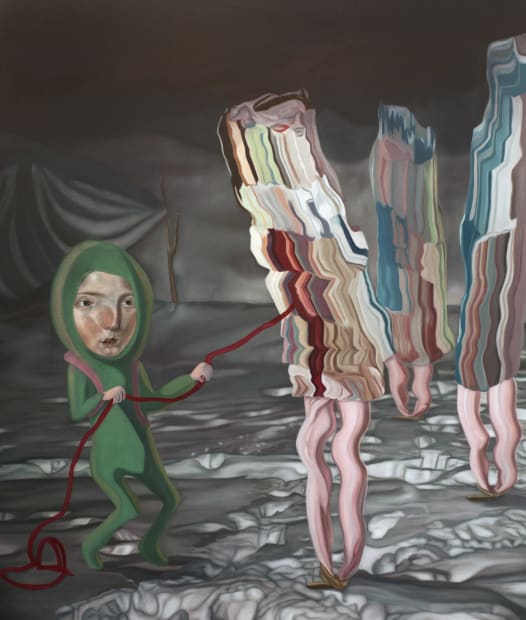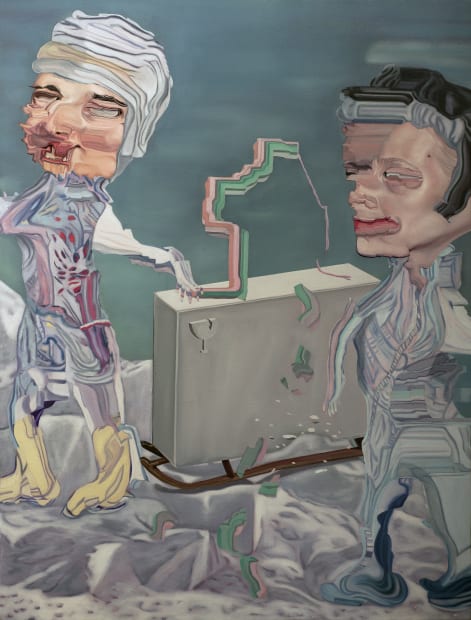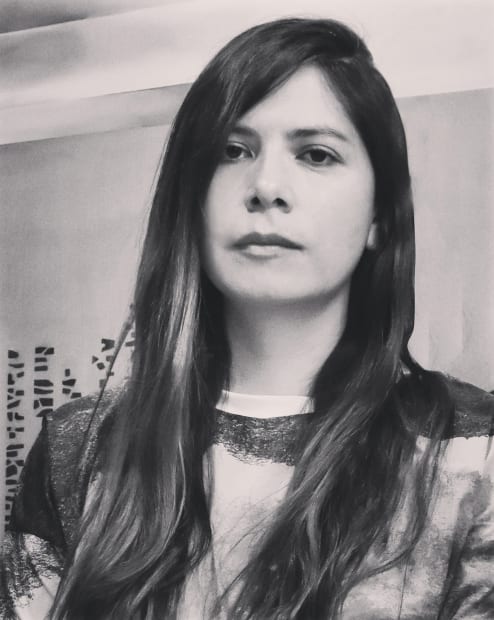Isabel Croxatto Galería is delighted to present Un Color Tiene Muchos Rostros (A Colour Has Many Faces), a solo exhibition by Carolina Muñoz featuring her latest series of paintings addressing the conditions of the "glitch phenomenon," a representation of the current times in the post-pandemic world. The exhibition gathers 26 paintings on canvas, wood and paper, accompanied by a curatorial text written by the Spanish art critic and researcher Juan José Santos.
Un Color Tiene Muchos Rostros is Carolina Muñoz's second solo exhibition with Isabel Croxatto Galería. Carolina Muñoz (Santiago, 1985) is a multi-awarded Chilean contemporary artist, known for her unique aesthetic and intellectual yet free approach to painting. Through her prolific practice that borrows images from cartoons and pop culture, the artist combines realistic characters inserted against abstract surroundings and plain bodies in a surrealist universe. The result is an imaginative hybrid stemming from the '90s animation, roaming inside a gallery space, flirting with what has been labelled as "art about art.".
-

Cromas, 2021. Oil on canvas, 130 x 110 cm
-
UN COLOR TIENE MUCHOS ROSTROS
Juan José SantosOur world lives in a constant state of stretching, flux, skidding. A glitch effect is produced that is so unfathomable that no one can see it, and whose colours are modified by the rest of the colours in circulation or extinction. An abysmal glitch.
Make no mistake; A Colour Has Many Faces [Un Color Tiene Muchos Rostros] is the translation of a theory into practice. In this movement of translation, of transference, or, if you like, of dragging, there is a loss of information and a gain of intuition.
The title of this exhibition comes from the fourth chapter of Josef Albers' book The Interaction of Colour (1963), a canonical text on the possibilities of colour. How an orange, or a blue, can be another orange, or a different blue, depending on its chromatic context. Depending on their relationships.
Colours have multiple faces. Now let's look at Carolina Muñoz's paintings, and return to the idea that what the artist presents us with is the illustration of a chromatic thesis, and that, in this exercise of illustration, the concept is transformed. What information remains attached to the artworks? Some characters, the messengers, of a nature in a permanent state of "deformation", appear on plinths (like the one labelled "No sé" ["I don't know"]), exposed with coloured lines, transferring geometric pieces with symbols similar to those of long-distance deliveries. Their own faces are also the product of another kind of remote transmission, only this time from the intangible circulation of images, found in dreams and taken from the internet, deformed through the paintbrush.
The weather is cold and they work outside. Snow surrounds them, and the white covers the stage of their actions, both on canvas and paper as well as in the representation of the landscapes of austral Chile, which houses the virtual version of this exhibition. Other entities, the chromas, are the pure colours in their essence; they are being mined by the explorers or collectors of colour, who, with this extracted matter, create sculptures. All this takes place in a parallel world, but with ideas that refer to our reality.
It is a chain of production, a complex and exhausting process of creation, packaging and circulation. Like that of an artist who works with colours, who makes works of art which end up in boxes and sent on a journey to any point on the planet? Who orders materials from Japan so that they arrive at her studio in Santiago, Chile, intact? We can speak of the biographical. Or about the collective, analysing a new form of capitalism by trawling; each second, thousands of people toil, sometimes in precarious conditions, to produce, pack, label and transport thousands of boxes. We can speak of relations of dependence, of the dependence of these relations.
We don't realise it, but all this movement of production and consumption, both material and digital, deforms the face of the planet. Our world lives in a constant state of stretching, flux, skidding. A glitch effect is produced that is so unfathomable that no one can see it, and whose colours are modified by the rest of the colours in circulation or extinction. An abysmal glitch.
Sweet dreams are made of this, travelling the world, the seven seas.
Everybody's looking for something. Some of them want to use you, some of them want to be used by you. Who am I to disagree?
Carolina Muñoz started this series from front to back. Perhaps we should, like her, start at the end. A Colour Has Many Faces will have continuations; this farewell is only the beginning.
The messengers, the explorers, the chromas, have a previous history that we do not know. That information is strained and unravelled. I am sure that what is important is what is suggested, or, as I stated at the beginning, what is intuited, which is a lot. There is an icy sensation of transience, that time is running out for the characters in these works. That their mission is urgent and fundamental.
Or perhaps it is all merely entertainment.
Let's pretend that what we have in our hands, while time shapes and deforms us, is urgent and fundamental.
Muñoz has an urgent need to have control of form, and her brushstroke is deformed when what she has to deal with is an abstract stain, or colour in its pure presence (does such a thing exist?). It happens to her just as it does to the characters she creates, or at least I assume it does. Or as Albers said, 'Only appearances don't deceive.'
Juan José Santos, art critic and curator.
September 2021. -
My work is related to a searching process
An analogy between my quest to explore technique and form, and at the same time with the transition and history of my characters. -

-

-









